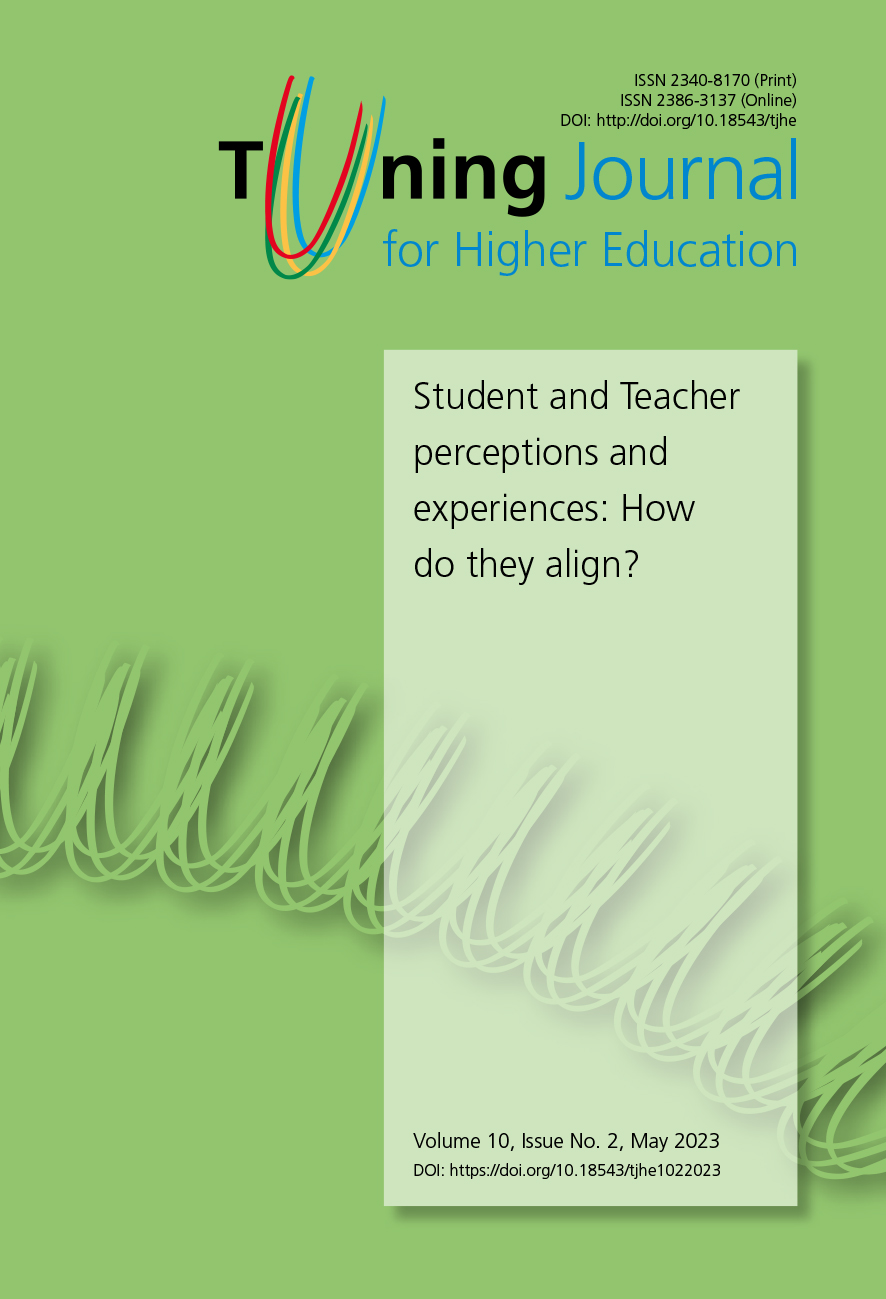Understanding critical thinking: A comparative analysis between university students’ and teachers’ conception
Abstract
Critical thinking is a key competence in higher education. However, little is known about the conception that students have of this competence. This study aims to analyze what university students understand by critical thinking and if these conceptions agree with those of university teachers analyzed in a previous study. A total of 263 participants took part in the study. The findings reveal that students tend to consider critical thinking as a competence related to reasoning/arguing and questioning/asking oneself. Also, that students’ conception about critical thinking differs from that of teachers. Whereas students tend to consider critical thinking as related to reasoning/arguing, questioning/asking oneself and, to a lesser extent, to acting/compromising. Teachers, on the other hand, tend to consider critical thinking as related to analyzing/organizing and evaluating. No significant differences were found regarding students’ gender and academic year. These results highlight the importance of considering students’ views when designing the curricula and the learning activities to develop students’ critical thinking.
Received: 30 June 2022
Accepted: 6 March 2023
Downloads
References
Bezanilla, María José, Manuel Poblete, Donna Fernández-Nogueira, Sonia Arranz, and Lucía Campo. 2018. “El pensamiento crítico desde la perspectiva de los docentes universitarios.” Estudios Pedagógicos 44, no. 1: 89-113. https://doi.org/10.4067/S0718-07052018000100089.
Bezanilla, María José, Héctor Galindo-Domínguez, and Manuel Poblete. 2021. “Importance of teaching critical thinking in higher education and existing difficulties according to teacher´s views.” Multidisciplinary Journal of Educational Research 11, no. 1: 20-48. https://doi.org/10.17583/remie.0.6159.
Cangalaya, Luis Miguel. 2020. “Habilidades del pensamiento crítico en estudiantes universitarios a través de la investigación.” Desde el Sur 12, no. 1: 141-153. http://dx.doi.org/10.21142/des-1201-2020-0009.
Choy, S. Chee. and Phaik Kin Cheah. 2009. “Teacher perceptions of critical thinking among students and its influence on higher education.” International Journal of Teaching and Learning in Higher Education 20, no. 2: 198-206.
Danczak, Stephen, Christopher Thompson, and Tina Overton. 2017. “‘What does the Term Critical Thinking Mean to You?’ A qualitative analysis of chemistry undergraduate, teaching staff and employers’ views of critical thinking.” Chemistry Education Research and Practice 18: 420-434. https://doi.org/10.1039/C6RP00249H.
Díaz-Larenas, Claudio Heraldo, Carlos Javier Ossa-Cornejo, Maritza Roxana Palma- Luengo, Nelly Gromiria Lagos-San Martín, and Javiera Ignacia Boudon Araneda. 2020. “El concepto de pensamiento crítico según estudiantes chilenos de pedagogía.” Sophia, Colección de Filosofía de la Educación 27: 267-288. https://doi.org/10.17163/soph.n27.2019.09.
Elder, Linda and Richard Paul. 2003.” Critical thinking: Teaching students how to study and learn.” Journal of Developmental Education 27, no. 2: 36-38.
Ennis, Robert H. 1991. “Critical thinking: A streamlined conception.” Teaching Philosophy 14, no. 1: 5-24.
Ennis, Robert H. 2011. “The nature of Critical Thinking: An outline of critical thinking dispositions and abilities.” Accessed January 30, 2022. https://education.illinois.edu/docs/default-source/faculty-documents/robert-ennis/ thenatureofcriticalthinking_51711_000.pdf.
Ennis, Robert H. 2018. “Critical thinking across the curriculum: A vision.” Topoi 37:165-184. http://doi.org/10.1007/s11245-016-9401-4.
Facione, Peter A. 1990. Critical thinking: A Statement of expert consensus for purposes of educational assessment and instruction. The American Philosophical Association Delphi Report. California: California Academic Press.
Facione, Peter A. 2011. “Critical thinking: What it is and why it counts.” Insight Assessment. Accessed February 3, 2022. https://www.student.uwa.edu.au/ data/assets/pdf_file/0003/1922502/Critical-Thinking-What-it-is-and-why-it-counts.pdf.
Flores, David. 2016. “La importancia e impacto de la lectura, redacción y pensamiento crítico en la educación superior.” Zona Próxima 24: 128-135. https://doi.org/10.14482/zp.24.8727.
Flores, Kevin L., Gina S. Matkin, Mark E. Burbach, Courtney E. Quinn, and Heath Harding. 2012. “Deficient critical thinking skills among college graduates: Implications for leadership.” Educational Philosophy and Theory 44, no. 2: 212-230. https://doi.org/10.1111/j.1469-5812.2010.00672.x.
Franco, Amanda Helena Rodrigues and Leandro S. Almeida. 2015. “Critical Thinking in College: Differential Analysis by Academic Year and Scientific Area.” In Critical Thinking in Education: Actual Challenges, edited by Caroline Dominguez, 25-30. Vila Real, Portugal: Universidade de Trás-os-Montes e Alto Douro.
Franco, Amanda. 2016. “What do ode to joy, the Nobel Peace Prize, umbrellas and cartoons have in common? Why critical thinking matters and how higher education moulds.” Higher Education for the Future 3, no. 1:108-124. http://doi.org/10.1177/2347631115610231.
Halpern, Diane F. 2014. Thought and knowledge: An introduction to critical thinking (5th ed). New York: Psychology Press. https://tandfbis.s3.amazonaws.com/rt- media/pdf/9781848726291/chpt_1.pdf.
Hervás, Rosa María and Pedro Miralles. 2000. “La importancia de enseñar a pensar en el aprendizaje de la historia.” Educar en el 2000 9: 34-40. http://hdl.handle.net/11162/85775.
Indrašienė, Valdone, Jegelevičienė, Violeta, Merfeldaitė, Odeta, Penkauskienė, Daiva, Pivorienė, Jolanta, Railienė, Asta, Sadauskas, Justinas, and Valavičienė, Natalija (2021). “The interaction between understanding of critical thinking and teaching/Learning of critical thinking skills.” Pedagogika/Pedagogy 144, no. 4: 25-42. https://doi.org/10.15823/p.2021.144.2.
Islamiyah, Millatul and Muchamad Sholakhuddin Al Fajri. 2020. “Investigating Indonesian Master’s students’ Perception of critical thinking in academic writing in a British university.” The Qualitative Report 25, no. 12: 4402- 4422. https://doi.org/10.46743/2160-3715/2020.4058.
James, Nickolas, Claire Hughes, and Clare Cappa. 2010. “Conceptualising, developing and assessing critical thinking in Law.” Teaching in Higher Education 15, no. 3: 285-297. http://dx.doi.org/10.1080/13562511003740858.
Kim, Kyoungna, Priya Sharma, Susan M. Land, and Kevin P. Furlong. 2013. “Effects of active learning on enhancing student critical thinking in an undergraduate general science course.” Innovative Higher Education 38: 223-235. https://doi.org/10.1007/s10755-012-9236-x.
Lee, Ning Yuan, Zijun Wang, and Bernice Lim. 2021. “The development of critical thinking: What university students have to say.” Teaching in Higher Education. https://doi.org/10.1080/13562517.2021.19734122021.
Llorens-Molina, Juan Antonio. 2018. “Autopercepción de los estudiantes acerca de la adquisición de las CTs y su contribución a la mejora de las actividades de aprendizaje.” In Congreso In-Red. Congreso Nacional de Innovación Educativa y de Docencia en Red (Universitat Politècnica de Valéncia, July 19-20, 2018), 1159-1171. http://dx.doi.org/10.4995/INRED2018.2018.8595.
Moloney, Barbara. 2004. “Critical, what? EAP students’ views on critical reading.” TESOL in Context 14, no. 1 and 2: 15-19.
Morris, Libby V. 2017. “Moving beyond critical thinking to critical dialogue. Innovative Higher Education 43: 377-378. https://doi.org/10.1007/s10755-017-9413-z
Moore, Tim. 2013. “Critical thinking: Seven definitions in search of a concept.” Studies in Higher Education 38, no. 4: 506-522. https://doi.org/10.1080/03075079.2011.586995.
Mulnix, Jennifer Wilson. 2012. “Thinking critically about critical thinking.” Educational Philosophy and Theory 44, no. 5: 464-479. https://doi.org/10.1111/j.1469-5812.2010.00673.x.
Olivares Olivares, Silvia Lizet and Mildred Vanessa López Cabrera. 2017. “Validación de un instrumento para evaluar la autopercepción del pensamiento crítico en estudiantes de Medicina.” Redie. Revista Electrónica de Investigación Educativa 19, no. 2: 67-77. https://doi.org/10.24320/redie.2017.19.2.848.
Paul, Richard and Linda Elder. 2019. The Miniature Guide to Critical Thinking. Concepts and Tools (8th ed.). London: Rowman and Littlefield.
Piergiovanni, Polly R. 2014. “Creating a critical thinker.” College Teaching 62, no. 3: 86-93. https://doi.org/10.1080/87567555.2014.896775.
Rodríguez Ríos, Rebecca Marilyn. 2021. “Pensamiento crítico y alfabetización digital en la escolaridad mexicana: Crisis a la luz de la posverdad.” Propuestas Educativas 3, no. 6: 140–154. https://propuestaseducativas.org/index.php/propuestas/article/view/707
Rodzalan, Shazaitul and Maisarah Mohamed Saat. 2015. “The perception of critical thinking and problem solving skill among Malaysian undergraduate students.” Procedia. Social and Behavioural Sciences 172: 725-732. https://doi.org/10.1016/j.sbspro.2015.01.425.
Saiz, Carlos and Silvia F. Rivas. 2008. “Evaluación en pensamiento crítico: Una propuesta para diferenciar formas de pensar”. ERGO Nueva Época 22-23: 25-66.
Sampson, Della C., Rita Moore, and Mary Jo Jackson. 2007. “Critical thinking: Do they really have “it” if they don’t know what “it” is?” In Proceedings of the Academy of Educational Leadership 12, no. 1: 47-51.
Schreglmann, Sinan and Fikriye Kanatli Öztürk. 2018. “An Evaluation of Gifted Students’ Perception on Critical Thinking Skills.” Journal for the Education of Gifted Young Scientists 6, no. 4: 1-16. https://doi.org/10.17478/jegys.463711.
Stupple, Edward J. N., Frances A. Maratos, James Elander, Thomas E. Hunt, Kevin Y. F. Cheung, and Aimee V. Aubeeluck. 2017. “Development of the Critical Thinking Toolkit (CriTT): A measure of student attitudes and beliefs about critical thinking.” Thinking Skills and Creativity 23: 91-100. https://doi.org/10.1016/j.tsc.2016.11.007.
Tenías Padrón, Martín José. 2013. “Pensamiento crítico en la universidad de la postmodernidad.” Trilogía. Ciencia Tecnología Sociedad 5, no. 8: 55-66. https://doi.org/10.22430/21457778.286.
Tian, Jing and Graham David Low. 2011. “Critical thinking and Chinese university students: A review of the evidence.” Language, Culture and Curriculum 24, no. 1: 61-76. https://doi.org/10.1080/07908318.2010.546400.
Velásquez de Suárez, Martha Judith and Hugo Figueroa Morán. 2012. “Desarrollo del pensamiento crítico en estudiantes de educación superior en El Salvador.” Panorama 6, no. 10: 7-20.
Villarini, Angel R. 2003. “Teoría y pedagogía del Pensamiento Crítico.” Perspectivas Psicológicas 3-4: 35-42.
Willingham, Daniel T. 2007. “Critical thinking: Why is it so hard to teach?” American Educator 31: 8–19. http://www.aft.org/sites/default/files/periodicals/Crit_Thinking.pdf.
Authors are required to sign and submit a copyright transfer agreement after acceptance but before publication of their manuscript. To that effect, they receive, from the Managing Editor of Tuning Journal for Higher Education, a standard copyright assignment form designed along the following lines:
1. Authorship:
The author who signs the copyright transfer agreement must be the sole creator of the work or legally acting on behalf of and with the full agreement of all the contributing authors.
2. Copyright and Code of conduct:
a) Authors warrant that their work is original; has not been previously copyrighted or published in any form; is not under consideration for publication elsewhere; its submission and publication do not violate TJHE Ethical Guidelines for Publication and any codes (of conduct), privacy and confidentiality agreements, laws or any rights of any third party; and no publication payment by the Publisher (University of Deusto) is required.
b) Authors are solely liable for the consequences that may arise from third parties’ complaints about the submitted manuscript and its publication in Tuning Journal for Higher Education (TJHE).
c) Authors grant to the Publisher the worldwide, sub-licensable, and royalty-free right to exploit the work in all forms and media of expression, now known or developed in the future, for educational and scholarly purposes.
d) Authors retain the right to archive, present, display, distribute, develop, and republish their work (publisher's version) to progress their scientific career provided the original publication source (Tuning Journal) is acknowledged properly and in a way that does not suggest the Publisher endorses them or their use of the wortk.
e) Authors warrant that no permissions or licences of any kind will be granted that might infringe the rights granted to the Publisher.
3. Users:
Tuning Journal for Higher Education is an Open Access publication. Its content is free for full and immediate access, reading, search, download, distribution and reuse in any medium or format only for non-commercial purposes and in compliance with any applicable copyright legislation, without prior permission from the Publisher or the author(s). In any case, proper acknowledgement of the original publication source must be made and any changes to the original work must be indicated clearly and in a manner that does not suggest the author’s and or Publisher’s endorsement whatsoever. Any other use of its content in any medium or format, now known or developed in the future, requires prior written permission of the copyright holder.


1.jpg)
1.jpg)
.jpg)
1.jpg)
.jpg)
.jpg)









